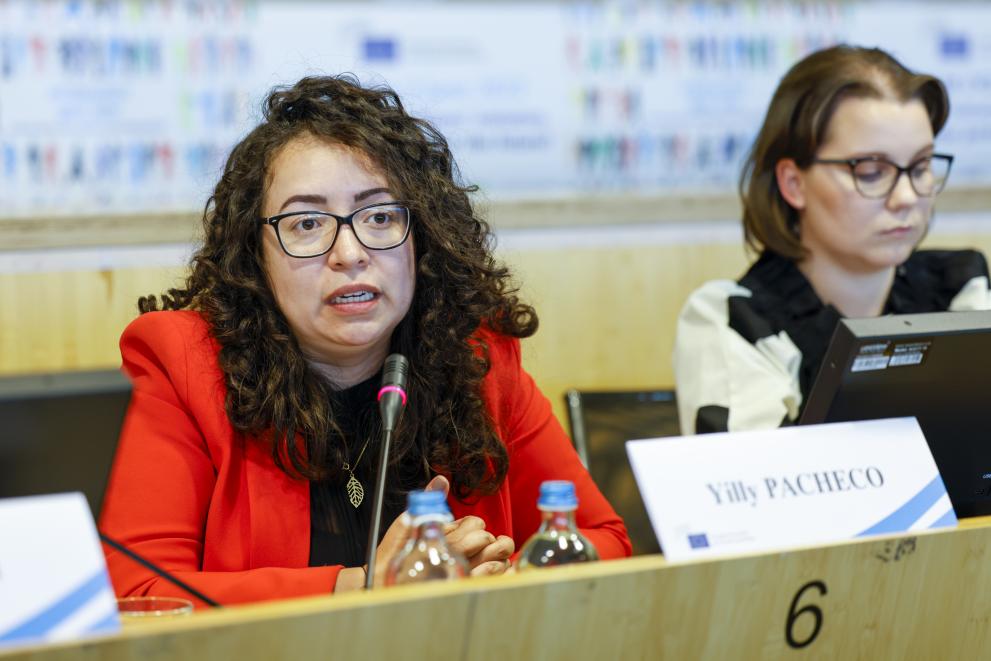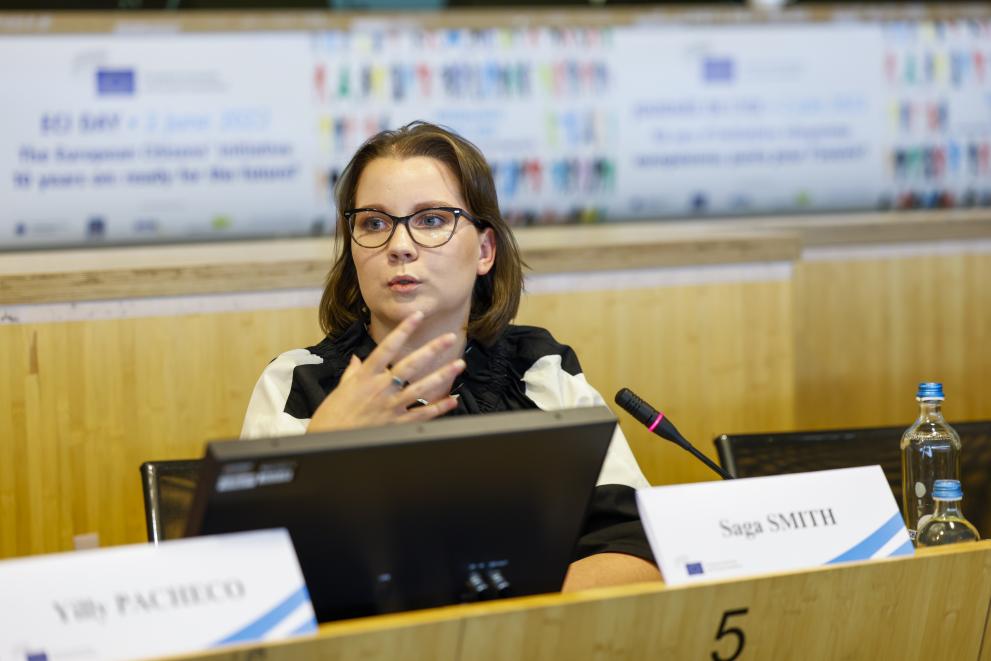
What can be done to further increase youth participation in EU policy-making? European citizens’ initiative organisers, policy experts and practitioners brainstormed for ideas ranging from being more transparent to using technology to connect with young people, as they gathered at the ECI Day 2022 at the European Economic and Social Committee (EESC) in Brussels.
The five speakers of the session ''An ECI for the next generation": Michael McLoughlin, Biliana Sirakova, Yilly Pacheco and young ECI organisers, Elsa Kraemer and Saga Smith, all provided insight on youth participation, ways to increase it and the challenges faced by youth organisers of European Citizens’ Initiatives.
Michael McLoughlin, Head of advocacy and communications at Youth Work Ireland, EESC member, rapporteur for the EESC opinion on the European Year of Youth 2022, emphasised that policy makers and institutions must be transparent with young people when engaging with them in terms of outcomes of discussions. In order to increase activism among the youth, it must be fun and engaging. Mr McLoughlin also highlighted that policy makers and institutions need to engage in a rational debate with the youth, ultimately giving the youth agency and making them feel heard. He concluded by stating that when communicating with the youth, the EU should not be patronising and should use technology as a way to connect with young people.
Caption: Michael McLoughlin speaking at the event online
Biliana Sirakova, EU Youth Coordinator, presented the different programmes the EU has set out to target youth participation. She presented the European Union Youth Strategy 2019-2027 which sets the framework to engage, connect and empower young people; the European Youth Dialogue which consists of EU Youth Conferences, events, debates and seminars at the national, regional and local level; Youth Wiki, an online encyclopaedia of national youth policies; and the European Year of Youth 2022 which aims to promote active citizenship of the youth and mainstream youth policy across all relevant policy areas. Ms Sirakova emphasised that what is lacking in dialogue between the institutions and the youth is the closing of the feedback loop. In agreement with Mr McLoughlin, she concluded that the institutions must communicate with the youth on the outcomes of their debates which acts as both a reassurance that young people’s input is valued and as a learning opportunity for the youth.
Caption: Biliana Sirakova presents EU Youth Programmes
Yilly Pacheco, Research Fellow at the Institute of International and European Law, Georg-August-Universität Göttingen, introduced and presented the ECI: From A to Z project. The ECI: From A to Z is an Erasmus+ project, developed by four universities, that promotes the use of the European Citizens’ Initiative as a participatory democracy tool. There are four phases to the project: 1) introductory session about the European Citizens’ Initiative, 2) an ECI online course 3) peer learning, and 4) creating model ECIs and presenting them to model EU institutions. Over 200 students have participated in this extracurricular activity. Ms Pacheco concluded by emphasising that the project's aim is to promote more active citizenship among university students and increase awareness of ECIs.
Caption: Yilly Pacheco presents the ECI: From A to Z
Elsa Kraemer, organiser of the initiative European Ecoscore presented their campaign and the challenges they are facing as youth organisers. The European Ecoscore initiative aims at establishing a compulsory transparent label indicating the environmental impact of the products sold on EU markets. Ms Kraemer stated that the initiative had over 80 youth volunteers from over 10 different European countries. She highlighted several difficulties encountered, including budgetary issues, lack of a professional structure or NGO or professional organisation support, the strict criteria of reaching 1 million signatures and issues with the e-id system. She emphasised that while organisers are motivated, many are full-time students who cannot devote their energy solely to the initiative. For example, over the past 10 months, the EcoScore organisers have gone to universities, spoken to local mayors and political actors to promote the initiative with the result of only collecting a few thousand signatures. Ms Kraemer concluded that the EU should not underestimate the ambition of young people, however the EU must be realistic and adapt the ECI as a tool to give the possibility to citizens to advocate for their projects in an effective manner.
Caption: Youth Organiser Elsa Kraemer of ECI European Ecoscore
Saga Smith, organiser of the initiative Voters Without Borders, Full Political Rights for EU Citizens presented the campaign as well as the challenges faced by the young organisers. The Voters Without Borders initiative demands universal suffrage for all EU citizens regardless if they live in the country of their origin or reside in a different Member State, with the goal to fight disenfranchisement and increase the general awareness of EU citizens’ voting rights. Ms Smith echoed Ms Kraemer’s point that budget is an enormous problem and challenge for running initiatives. The second biggest problem is the lack of public awareness of what the European Citizens’ initiative is. She stated that visibility is the most important issue when it comes to using this tool because without visibility, one cannot collect signatures. Ms Smith concludes with two points of intervention: 1) for the EU to consider discussing initiatives that do not reach the 1 million signature target and 2) for the EU to rethink the age required to sign an ECI and lower it to 16, allowing the youth to have an active role in this participatory democracy tool.
Caption: Youth Organiser Saga Smith of ECI Voters without Borders
All speakers agredd that, as with all participatory democracy tools, there is still more to be done to engage young people and support them as organisers of European Citizens’ Initiatives. They also agreed that one way to increase awareness of the European Citizens’ Initiative tool and participation is to teach EU civic education in primary and secondary schools of all Member States.
Interested in hearing more of what was said in this session? Click here:
Read more about young people and the European Citizens’ Initiative:
‘ECI Model’: How Students Learn to Become Active European Citizens in Practice
Young Italians Test the European Citizens Initiative as a Tool to Mobilise for the Climate
Engaging Higher Education Students with the European Citizens’ Initiative
Contributors
Vasiliki MustakisParticipatory Democracy Coordinator, European Citizen Action Service (ECAS)
The opinions expressed on the ECI Forum reflect solely the point of view of their authors and can in no way be taken to reflect the position of the European Commission or of the European Union.






Leave a comment